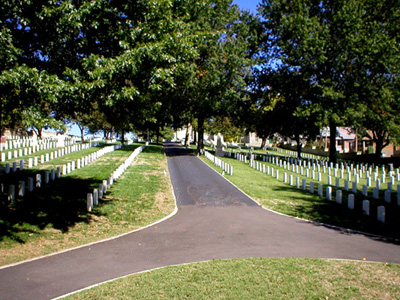Jefferson City National Cemetery
1024 East McCarty Street
Jefferson City, MO 65101
Phone: (314) 845-8320
FAX: (314) 845-8355
To schedule burials: See General Information
|
Office Hours:
Cemetery maintained by Jefferson Barracks National Cemetery.
Visitation Hours:
Open daily from dawn until dusk.
|

|
Burial Space: This cemetery is closed to new interments. However, space may be available in the same gravesite for eligible family members.
Acreage: 2.0
Number of Interments
Thru Fiscal Year 2008: 1,802
General Information Kiosk on Site? No
Floral/Ground Regulations
|
Directions from nearest airport:
The cemetery is approximately five miles west of Memorial Airport. From the airport, take Highway 54 turning left (west) across the bridge to Jefferson City. Take Highway 50 exit east and travel to Clark Avenue (five traffic lights). Exit on Clark Avenue and turn left (north) at the “T” intersection with a traffic light, turn left (west) on McCarty Street. Travel one block to the cemetery on your left.
|
GENERAL INFORMATION
To schedule a burial: Fax all discharge documentation to the National Cemetery Scheduling Office at 1-866-900-6417 and follow-up with a phone call to 1-800-535-1117.
The Jefferson Barracks National Cemetery maintains this cemetery. Please contact Jefferson Barracks at the telephone number listed above.
back to top
HISTORICAL INFORMATION
The region around Jefferson City National Cemetery has a rich and international history. French explorers Louis Jolliet and Jacques Marquette first surveyed the mouth of the Missouri River in 1673. In 1682, the French explorer René-Robert Cavelier, Sieur de la Salle, traveled down the Mississippi and claimed the extended area for France. In 1715, Antoine de la Mothe Cadillac opened a lead mine in present-day Madison County, Mo.; Philip Renault, another Frenchman, worked the mines in this area with slaves until 1744. In the mid 18th century the first two permanent white settlements, St. Genevieve and St. Louis, were carved out of the region. Soon after 1789, the Spanish built the El Camino Real (the King’s Highway) northward from New Madrid to St. Louis. It is still used today, designated as U.S. Highway 61.
In the early 1810s, Jefferson City, then known as Lohman’s Landing, became an increasingly important trading post for immigrants beginning their westward journey on the Santa Fe and, later, Oregon trails. As part of a compromise plan between major population centers in the eastern and the western portions of the state, Jefferson City was chosen as the capital in 1821 and the legislature began to meet there five years later. In 1839 the site was incorporated as a city.
During the Civil War, the city’s sentiments were divided between North and South. Jefferson City, however, saw little military action with one exception. On Sept. 27, 1864, a guerrilla force commanded by William Anderson burned a train and killed 17 Union soldiers and several civilian passengers. Many of the soldiers had been wounded on the battlefield and were returning home. Later that day, a federal force followed Anderson and his men to their camp where a bloody battle took place. The Union troops were routed and forced to retreat. Almost 10 years later, the remains of the men who had died in the skirmish were reinterred in Jefferson City National Cemetery.
Burials in Jefferson City National Cemetery date to summer 1861; its original purpose was for the burial of Civil War soldiers from the surrounding area. The site of the cemetery, which local residents Israel and Mary Read sold to the government, was surveyed for classification as a national cemetery during the war. However, its official designation did not occur until 1867, after the war and approximately 350 interments were completed.
Jefferson City National Cemetery was listed on the National Register of Historic Places on Oct. 1, 1998.
Monuments and Memorials
The 39th Regiment Monument of Centralia, Mo., was erected around 1868. It commemorates members of Companies A, G and H of the 39th Regiment of the Missouri Volunteer Infantry who were killed in action at Centralia on Sept. 27, 1864. The monument marks the trench burial of the 118 men interred there.
back to top
NOTABLE PERSONS
back to top
FLORAL/GROUNDS REGULATIONS
Cemetery cannot be used as a picnic grounds
Visitors should not litter the grounds, cut, break or injure trees, shrubs or plants or otherwise conduct themselves in a manner not in keeping with the dignity and the sacredness of the cemetery.
All graves will be decorated on the workday immediately preceding Memorial Day with small U.S. flags, which will be removed on the first workday after Memorial Day. Flags are not permitted on graves at any other time.
Cut flowers may be placed on graves at any time. Metal temporary flower containers are permitted. Floral items will be removed from graves as soon as they become faded and unsightly.
Artificial flowers may be placed on graves only during the period of Oct. 10 through April 15. Plantings, statues, vigil lights, glass objects of any nature and any other type of commemorative items are not permitted on graves at any time. Potted plants will be permitted on graves 10 days before, through, 10 days after Easter Sunday and Memorial Day.
During the Christmas season, Christmas wreaths, grave floral blankets and potted plants will be permitted commencing Dec. 1 and allowed to remain on the grave through Jan. 20. Grave floral blankets may not exceed two by three feet in size.
back to top
|


